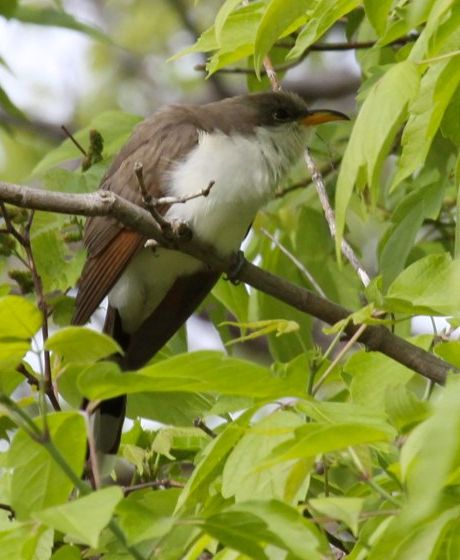
Yellow-billed cuckoos are usually hard to find. They skulk in the treetops – like this one is doing – and are found only by the sound of their amazing voices.
That’s why I was surprised to see three cuckoos in the open recently. Two were singing and chasing while a third one watched. Was this territorial behavior? Courtship? In July? I decided to find out.
Yellow-billed cuckoos return to our area in April and May but they tend to nest from late June to July because they wait for an abundance of their favorite foods: caterpillars and cicadas. In my experience this gives cuckoos extra time to be secretive while other birds are visibly courting and nesting.
Cuckoos may be secretive but they’re more versatile when they nest, choosing among three methods depending their food supply.
In years of normal or low food abundance, yellow-billed cuckoo pairs go the traditional route of building and using their own nests, but in years of explosive caterpillar or cicada infestations – such as 17-year cicadas – female cuckoos produce extra eggs, and they need to put them somewhere.
Sometimes they breed co-operatively. Two females share the same nest with a male and all three of them tend the young. The males handle overnight incubation so I think the “co-op” guys must struggle to cover 5-11 eggs instead of the usual 2-3.
Alternatively, the females lay eggs in other birds’ nests, choosing those whose eggs are the same blueish-green color as their own. According to BNA Online, yellow-billed and black-billed cuckoos are “the only known facultative, interspecific brood parasites among altricial birds.” “Facultative” means that they can but don’t always do this, so cuckoos don’t have the bad reputation the brown-headed cowbird has.
Yellow-billed cuckoos have one more surprise up their sleeves. When their nestlings are about six days old they become fully feathered in only two hours. Their feathers literally burst from the feather sheaths. Imagine Mrs. Robin’s shock when one of her kids goes from bare down to flight feathers so fast. Surprise! That one’s a cuckoo.
Now that’s versatile.
(photo by Chuck Tague)
p.s. Based on the lateness of the cicadas this year, this is probably a low-food-supply year for cuckoos.